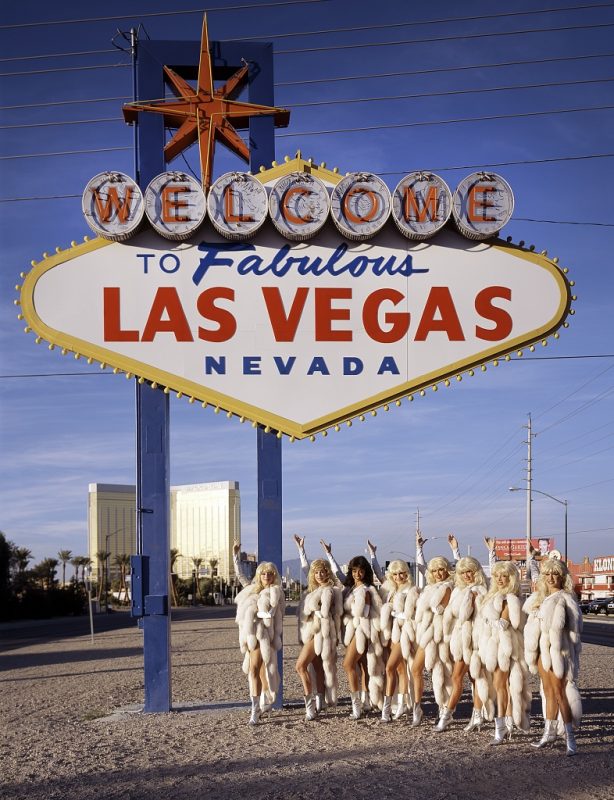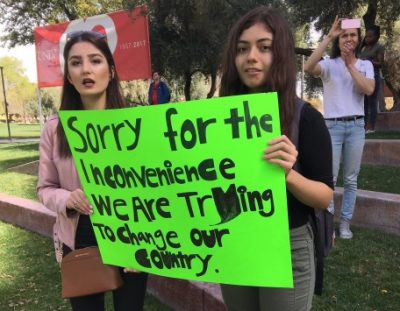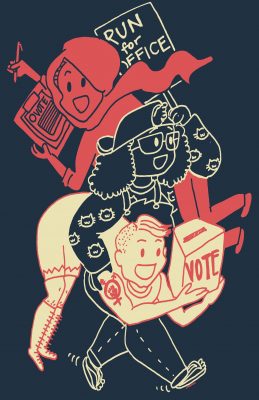Scratch the surface and women’s history is everywhere in Las Vegas
14 May 2018 – Joanne Goodwin
Las Vegas Series 2018, community history, sense of place, environment, education, conference, gender/sexuality, 2018 annual meeting
Editor’s note: This is the final post in a series of pieces focused on Las Vegas and its regional identity which were posted before and during the NCPH Annual Meeting in Las Vegas in April.

Showgirls in front of the historic Las Vegas sign. Photo credit: Carol Highsmith, Library of Congress
The casino and entertainment industries in Las Vegas have used women’s bodies to sell the city since the 1950s. One could say the image of women was ubiquitous. Yet, their lives remained invisible. When I arrived in the city to teach at UNLV, very little was known about women’s experiences in shaping the valley’s history. Today that has changed.
UNLV’s Special Collections and Archives houses the decades-old Nevada Women’s Archives with manuscript and photo collections. The Las Vegas Women Oral History Project is part of that collection as is the Women in Nevada History Digital Legacy Project. The Women’s Research Institute of Nevada joined with Vegas PBS to produce MAKERS: Women in Nevada History, the first documentary to examine women’s history in the state. The collaborative process to create these research materials for students, researchers and the public has taken many years of my professional life and allowed me to interact with students, faculty, and community members in ways I never expected. It also brought me into the field of public history.
As you recall your experience at the conference, consider the following handful of public sites where women in this valley shaped the evolution of Las Vegas.
The Old Mormon Fort, built in 1855, is now a state park. While the Mormon settlement only lasted a few years, the history of that site draws its significance from Helen Stewart. She reluctantly moved to this outpost in the Mojave Desert with her husband Archibald and their children in 1883 with the understanding that the family would move on to California in a few years. But neighbors murdered Archie and Helen stayed to work and expand the ranch. In 1902, she sold most of her ranch to Senator William Clark, who would auction off lots in a few years. Helen Stewart remained in Las Vegas and became a builder of several institutions in the new town.
The Las Vegas Strip became a national scenic byway in 1995. Whether you marvel at the lights or wonder about the energy usage, do consider the thousands of women and men workers who have entertained, managed, and provided services to visitors for over seventy years. And if you want to read some of their stories, check out Changing the Game: Women at Work in Las Vegas, 1940-1990.

Anti-gun violence rally, UNLV, 2018. Photo credit: Joanne Goodwin
The growth of metropolitan Las Vegas was the story until the Great Recession during which the bottom dropped out of the real estate market and businesses closed. While growth has returned recently, a metropolis is more than its size, industries or government. It is the people who through their organizations attempt to meet the needs of residents. This community-building includes schools, parks, public libraries as well as the multitude of non-profit organizations. Historically, women excelled at community-building, creating the first public library, green spaces, social welfare organizations, battered women shelters, and rape crisis centers. For an example, check out the profile of community activist Florence McClure in the Women in Nevada History Digital Legacy Project.

Jean Munson designed the official artwork for the 2018 Women’s March kickoff in Las Vegas. Image credit: Jean Munson
From gaining the vote through school desegregation, from the battle for the Equal Rights Amendment to the recent Women’s March and Rally in January 2018, organized women have been vital in creating change and moving towards social justice in Nevada and Las Vegas. The list is long, yet there are barely any public sites yet established to recognize the actors and organizations. A recent success story is the Westside School. Listed in the National Register of Historic Places, the structure is the oldest remaining school in the city. It was built on land donated by Helen Stewart (see above), served black and Paiute children, and provided jobs for African American teachers, male and female. It is currently a community resource for several organizations.
Scratch the surface of most of the sites you’ll see or hear about in Las Vegas and women will have made history there.
~Joanne Goodwin is a professor in the department of history at University of Nevada, Las Vegas. Her research and teaching interests are in 20th century U.S. history with a specialization in women and gender history. Her publications include: Gender and the Politics of Welfare Reform (University of Chicago Press, 1997) and the Encyclopedia of Women in American History, 3 vols. (2002), which she co-edited.



